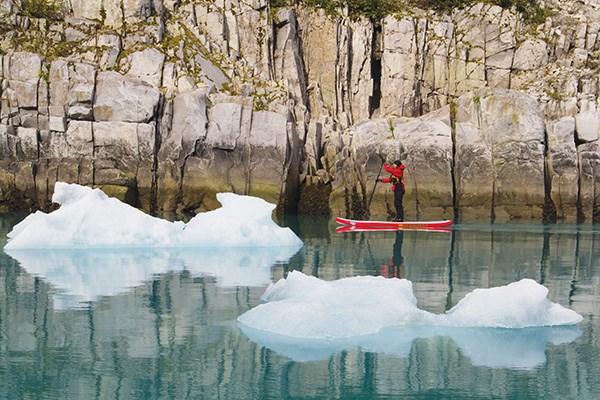Michelle Eshpeter and friend Lee Paskar just completed the first backcountry stand-up paddleboarding expedition in Glacier Bay National Park, Alaska.
The pair paddled for four days at the end of September around the Beardslee Islands, a popular kayaking destination but one no other paddleboarders had taken on, according to Eshpeter.
“This is the coolest way to paddle around icebergs,” she said last week, speaking to The �鶹����� from her home in Whitehorse. “You just get such a cool perspective when you are standing and are standing beside them, and you can look down and see the underside of the icebergs and things like that.”
Squamish’s Norm Hann, Eshpeter’s paddleboarding instructor and mentor, inspired this trip.
Stand-up paddleboarding is the world’s fastest growing sport, Hann said, and �鶹�����is an incredible hub for it.
In April, Eshpeter took a two-day course with Hann and the two hit it off right away.
Eshpeter, a fitness instructor, followed up her initial instructing course with a coastal touring class taught by Hann over the summer.
Hann said Glacier Bay is a great spot for paddleboarders, but not everyone should grab a board and head up.
“It’s a very dynamic coastal environment, and my advice is to go with someone who is a qualified wilderness guide and knows what they are doing, or to be very self-sufficient and experienced in dealing with coastal weather and remote ocean travel,” he said.
“Glacier Bay is a UNESCO World Heritage site, and most of the places have protocols and permits that are needed for travel through these areas.”
The ocean can never be taken lightly, Hann added. “So many people get into the sport without proper training and as a result, we have already witnessed near-misses, accidents and deaths.”
Eshpeter was originally attracted to paddleboarding because of the peacefulness of the activity.
“Travelling down the water was such a beautiful way to spend a day,” she said.
She quickly realized how versatile the board and the sport could be.
On her fifth time on the board, she loaded it up with backcountry gear and went paddling down the Yukon River for an overnight trip. After that, heading out on a longer expedition around the Beardslee Islands was a natural next step, she said, adding that kayakers had raved about trips around the glaciers.
Spotting wildlife was a highlight of the expedition, she said. “You could just see how the wildlife thrive there, and it made you feel that you were really, really in nature. It felt so untouched; everywhere you looked there were bears roaming the beaches, seals following you as you paddled, and they were all playing.”
The trip included challenges. On the third day, the two friends were supposed to cross the rough waters of Bear Trap Cove, which is where the Beardslee Islands end and open water begins.
“We had a four-foot swell and there was a 20-knot wind blowing over it,” Esphpeter recalled. They had to cross to get some fresh water.
Because Paskar was less experienced, they decided Eshpeter would cross on her own.
“That ended up adding a little bit of excitement to the adventure, for sure,” Eshpeter said with a hearty laugh.
She had to paddle through extremely rough water for several hours across the cove and back, but she did it.
Paskar was worried because he could see Eshpeter crossing on the choppy water, and humpback whales were surfacing all around her.
“I didn’t see one of them – I had to concentrate to make the crossing – but for him, he said it was the craziest sight,” Eshpeter said. “Little did I know.”
She said she hopes from hearing about her adventure, others develop a passion for cold-water paddling.
“Yes, stand-up paddleboarding can be done in cold-water areas, and it can be a really good backcountry tool as well,” she said.
Eshpeter is already planning her next adventure: a winter combined backcountry skiing and paddleboarding expedition in Haines, Alaska.



